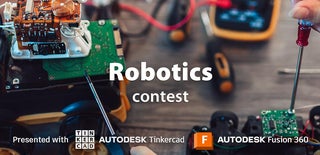Introduction: 3D Printed Combat Robots!
In this Instructable I will explain how to begin building a 3D Printed Combat robot.
I am currently a Manufacturing/Mechatronics Teacher in Tennessee. This is a project meant to push students past just learning how to draw things in CAD based off of practice problems. Students are given the opportunity to design an actual robot using existing hardware and their own measurement skills. This could be a project based in the classroom, or one you do on your own and go to a competition. I will cover aspects of both in the guide.
I will cover the following topics throughout:
- What are combat robots, and what are the rules?
- Where can I find combat robots near me?
- What do I need to build the robot?
- How do I design a combat robot?
- What to expect at your first event?
Supplies
The following things are what you will need to build a 3D Printed Combat Robot:
- 3D Printer, or a friend with a 3D Printer
- PLA+ or ABS Filament
- Drive Motors at least 2 motors I would recommend either of the motors below
- Turnabot n20 2000RPM
- Repeat Robotics
- Weapon Motor(optional):
- Brushless Motor
- Electronic Speed Controller(ESC)
- Drive ESC
- Scorpion Nano
- Weapon ESC(only needed if you have a weapon motor)
- BL-Heli
- Reciever/Transmitter
- FlySky
- Battery
- 2S Battery
- 3S Battery
- Wheels
- Hubs
- 20 Gauge stranded Wire
- Soldering Iron
- Metric Screws
- Power Switch
Step 1: What Are Combat Robots?
Combat robots are remote controlled robots designed to fight in an arena against other robots. Combat robots have a variety of ways to fight either by spinniner weapons, hammers, saws, lifters, and wedges. If you have seen the TV show Battlebots, you have seen 250 Pound combat robots. But did you know there are smaller weight classes that you can build your own bot for?
These are the four common weight classes you will see at smaller events:
- Fairyweight - robots that weigh a max of 150 grams any materials are allowed for this class including 3D Printed, Plastics, and metals.
- Antweight - 1 pound combat robots made using a variety of materials
- Plastic Ants - 1 Pound combat robots made using only 3D Printed chassis and weapons.
- Beetleweight - 3 Pound bots made of a variety of materials.
This Instructable will cover the 1 Pound Plastic Ant class because I feel its one of the easiest to enter for first robot, but this guide could still be used as a guide for regular ants and Fairyweights as well.
Step 2: Rules
Many event organizers stick with the SPARC Rules for combat robots. I will not list all of them here but give a quick summary of a few that go with the Plastic Ant Class. Please read through all of the rules before getting too far into this project to make sure you have a good understanding of how the events will run.
- Plastic ants must be made of 3D Printed parts and weapons.
- Many events require parts to be made of PLA, PLA+, ABS, PET, or PETG.
- Plastic ants may not use any metal to reinforce the chassis or weapon.
- Metal Fasteners are permitted so as they are not making the robot any more sturdy or making a weapon do more damage.
- Wheels are up to you, they can be 3D Printed or foam. I would reccomend the foam ones in the link because they are very light and offer good grip.
- Weapons must have a locking mechanism on them any time out the Arena.
Step 3: Where to Find an Event
Finding and registering for an event is fairly easy. There are two sites to check for competitions happening and from there you can design which one is the best for you.
The first site is Robot Combat Events
The Second is Builders Database
Both of these sites offer all of the information you need to locate and register for a contest.
If you are planning on doing this in your own classroom here are a couple ways to do it:
- Compete with non destructive bots - mainly wedges and lifters in an open air arena with a pushout box. Turnabot has a great guide/arena and bots to do this at the 150g weight class.
- Build your own Arena with safety glass to host full combat robots. You will need to do this option if you have any robots with spinning weapons. There are several guides out there, but I would recommend at least .25" thick plexiglass walls.
Step 4: How Do I Design a Combat Robot?
There are several options for getting files for 3D Printing. If you are new to 3D Modeling, I would highly recommend TinkerCAD because it is the easiest modeling software to learn.
If you are familiar with 3D Modeling/CAD a good option is Autodesk Fusion360 or Onshape.
Here is a link to a few common components design by Turnabot. They offer good options for tinkerCAD to design something with n20 Motors. You can import the STL Files right into TinkerCAD and easily design around them.
Quick tip for designing bots, I would keep it as small as possible and offer the thickest walls you can while staying under weight.
When you are modeling, please be sure to design with 3D Printing in mind, look out for overhangs, etc.
Step 5: 3D Print
When 3D Printing a combat robot there a few things you need to keep in mind.
One thing is to decide on the material you are using. Many competitions will require you to stick with ABS, PLA, PLA +, PETG, or PET. Be sure to contact your local Contests host to determine the rules for the event My preference list for materials is the following:
PLA+ - Cheap and very strong and easy to print using Standard PLA Settings
ABS - Cheap and strong but harder to print with
PLA - Cheap and Easy to print
PETG - avoid if you can. It likes to shatter and does not have much Impact Resistance.
If you are allowed any other filaments at your event and have a printer that can handle them:
Nylon would be the preferred material. It has the best mechanical properties.
TPU is also a strong material and has flex to it so it can absorb hits a lot better than PLA. It also does not require super hot temperatures to print.
The other thing you need to do is change a few settings in your slicer. You will need to find these in the slicer you use for your 3D Printer.
Appropriate settings for the material you are printing.
I would try to print a 5-10 degrees hotter than you normally would to allow for the layers to bond together a little better.
Walls/Perimeters - I suggest 4 or 5
Layer Height - .15
Infill - 50 to 99% adjust this to get the weight that you prefer.
Once you adjust those setting you can print out your bot using the material of your choice.
Step 6: Soldering
While Printing you will need to make all of your connections for your robot attached is a sketch of what it should look like.
Step 7: Install Motors and Wheels
Press Motors in place, then secure using Zip ties.
Once motors are secured, install the Hubs on to the shafts of the motors, be sure to tighten down the grub screw. If you want to make it more secure, you can use loctite on the grub screw to make sure it doesnt loosen up.
After the hubs are installed you can press the foam wheels on to the hub.
Step 8: Install Electronics
Start my placing the Receiver and battery in their locations. you can use double sided tape to hold them down.
once they are in place, carefully route all of your wires into the robot. you may secure them with tape or zip ties to keep them neat.
Plug the two connectors from the ESC to your reciever in ports 1 and 2. Pay attention to where the + - and signal wires are to be plugged.
Use a clamp or something to secure the weapon to prevent it from spinning while outside of the arena.
Finally, connect your battery.
Step 9: Test Run
VERY IMPORTANT!!!!!!!!
DO NOT TEST A ROBOT WITH A SPINNING WEAPON WITHOUT A SAFETY ENCLOSURE!!!
If you have it all finished, and have made a basic control bot like the wedge bot attached, you can now make sure your bot is propped up so the wheels cannot touch anything. Turn on your robot, and then the controller.
Test to make sure it drives correctly. If the motors are reversed, you will need to change the where the motors are plugged into. If that still doesnt work, you will swap the the

This is an entry in the
Project-Based Learning Contest










Comments